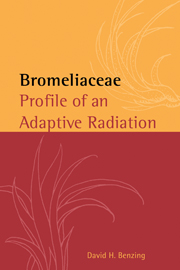Book contents
- Frontmatter
- Contents
- List of contributors
- Preface
- Acknowledgments
- Glossary
- Abbreviations
- Part one Brief overview
- Part two Basic structure, function, ecology and evolution
- 2 Vegetative structure
- 3 Reproductive structure
- 4 Carbon and water balance
- 5 Mineral nutrition
- 6 Reproduction and life history
- 7 Ecology
- 8 Relationships with fauna
- 9 History and evolution
- Part three Special topics
- Literature cited
- Name index
- Subject index
- Taxon index
8 - Relationships with fauna
from Part two - Basic structure, function, ecology and evolution
Published online by Cambridge University Press: 19 January 2010
- Frontmatter
- Contents
- List of contributors
- Preface
- Acknowledgments
- Glossary
- Abbreviations
- Part one Brief overview
- Part two Basic structure, function, ecology and evolution
- 2 Vegetative structure
- 3 Reproductive structure
- 4 Carbon and water balance
- 5 Mineral nutrition
- 6 Reproduction and life history
- 7 Ecology
- 8 Relationships with fauna
- 9 History and evolution
- Part three Special topics
- Literature cited
- Name index
- Subject index
- Taxon index
Summary
Vascular plants literally energize every major land-based ecosystem. They also furnish co-occurring biota additional resources and services unrelated to nutrition. Bromeliaceae stand out on this second count by providing an extraordinary array of benefits to a diverse, incompletely inventoried fauna (e.g., Figs. 8.1–8.4) and even some flora (Fig. 8.4B). For example, many of the phytotelm types achieve keystone status more as animal habitat than as food (Fig. 2.4). These primarily arboreal bromeliads also lend a distinctive visual aspect to forests throughout the Americas while they contribute inordinately to the often exceptional biocomplexity of the same speciesrich communities (Fig. 1.4F).
Visits to bromeliads by animals to collect pollen, nectar and fruit are considered in Chapter 6; carnivory, mycorrhizae, symbiotic diazotrophs, and certain aspects of ant-house and ant-gardened mutualisms receive due treatment in Chapters 4 and 5. Conversely, enemies and the ants that deter predators for many Bromeliaceae have largely gone unmentioned. Evidence of how extensively family members serve still another set of organisms, many of which occupy and release nutrients from litter impounded in phytotelmata, consists mostly of checklists of surveyed taxa. As we shall see, even this preliminary literature indicates that the bromeliads influence events in many Neotropical ecosystems far beyond what relatively small body size and usually modest contributions to aggregate phytomass would predict.
Predators and pathogens
No comprehensive records of herbivores or pathogens exist for Bromeliaceae, nor does the available information suggest extraordinary susceptibility. If anything, immunity to certain wide-ranging plant-users like the leaf-cutting ants and larger grazers may be relatively well developed.
- Type
- Chapter
- Information
- BromeliaceaeProfile of an Adaptive Radiation, pp. 405 - 462Publisher: Cambridge University PressPrint publication year: 2000



